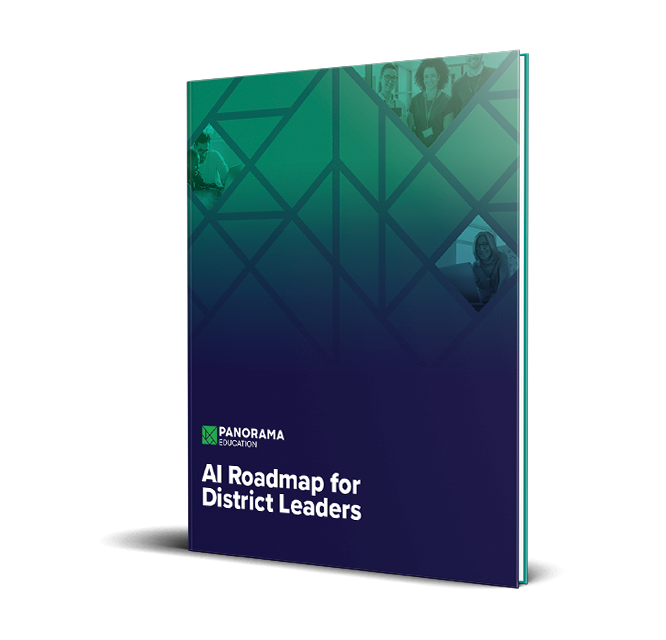Each school day is crucial in a student's educational journey. Even one absence represents a missed opportunity for learning and development. Across the nation, chronic absenteeism impacts millions of students, jeopardizing their academic achievement and future prospects.
To address this issue and boost student success, educators need to recognize early warning signs of absenteeism and implement effective strategies to maximize it. Read on to explore the significance of attendance, early warning signs of absenteeism, and how Panorama supports schools in promoting consistent attendance.
Table of Contents
Why Does Attendance Matter for Student Achievement?
Early Warning Signs and Intervention
The Role of Life Skills in Attendance
Strategies for Improving Attendance
How Panorama Supports Attendance Improvement
Partner With Panorama to Boost Student Success
New Research and Strategies for District Leaders
What Is Chronic Absenteeism?
Chronic absenteeism is when a student misses 10% or more of school days (about 18 days in a typical 180-day school year). This encompasses all absences, including those due to illness, family emergencies, and unexcused reasons. It's important to distinguish chronic absenteeism from truancy, which specifically refers to unexcused absences without valid reasons or parental permission. While truancy often involves non-compliance with attendance laws and may require intervention from school authorities or law enforcement, chronic absenteeism is a more comprehensive measure of a student's overall attendance pattern.
The prevalence of chronic absenteeism in the U.S. has been concerning. In the 2018-2019 school year, 15% of students were chronically absent. The COVID-19 pandemic intensified those challenges, leading to a significant increase that nearly doubled absentee rates, affecting 14.7 million students nationwide in the 2020-21 school year.
Today, this crisis continues to impact students across various grade levels and demographic groups. Elementary students risk missing crucial developmental milestones in reading, writing, and math, while high school students may struggle to earn necessary graduation credits. Notably, students from low-income backgrounds are four times more likely to be chronically absent, often due to factors beyond their control, such as unreliable transportation.
Why Does Attendance Matter for Student Achievement?
The importance of attendance in student success cannot be overstated. Research consistently demonstrates that chronic absenteeism sets off a chain reaction of negative effects on academic performance, with consequences that compound over time.
Early attendance patterns are particularly crucial. Students who experience chronic absences in preschool, kindergarten, and first grade often struggle to achieve grade-level reading proficiency by third grade. This milestone is critical, as students who don't meet it are four times more likely to leave high school without graduating compared to their peers who read proficiently.
What’s more, attendance patterns in later years continue to play a significant role. Irregular attendance serves as a strong indicator of potential dropout, with persistent low attendance in grades 8-12 substantially raising the risk of not completing high school.
The implications of these attendance-related challenges extend far beyond the classroom. Students who don't complete high school frequently face significant hurdles in adulthood, including increased risk of economic hardship, health issues, and involvement with the criminal justice system.
Early Warning Signs and Intervention
Research indicates that students who miss 2-4 days in September are likely to be absent for nearly 30 days throughout the school year. This underscores the importance of tracking attendance issues early to address potential problems proactively. Schools should implement early warning systems that leverage data analytics to monitor attendance patterns and other key indicators, enabling educators to intervene before chronic absenteeism becomes widespread.
Moreover, early warning systems can reveal patterns in absenteeism, such as frequent absences on particular days or during specific periods. These insights help schools understand the root causes of attendance issues and develop targeted, effective strategies to address them. By harnessing the power of data, schools can take a proactive approach to improving attendance and supporting student success.
The Role of Life Skills in Attendance
Identifying at-risk students is just the first step; encouraging attendance requires practical strategies. While data can reveal underlying factors causing absenteeism, the root cause isn't always apparent. Recent research highlights a strong correlation between higher attendance rates and three key life skills: classroom engagement, self-management, and self-efficacy.
-
Classroom Engagement: Classroom engagement measures a student's level of interest, participation, and emotional investment in learning activities. Students who are engaged are statistically more likely to attend school regularly compared to their disengaged peers. Schools can assess this metric through student surveys with questions such as "How excited are you for this class?" or "How interested are you in this subject?"
-
Self-Management: Self-management refers to a student's ability to regulate their emotions, behaviors, and thoughts across various situations. This skill set encompasses time management, goal setting, and stress handling. Students with strong self-management skills are better prepared to meet the demands of school life, which can help reduce absenteeism. These students typically manage their schedules effectively, complete assignments punctually, and navigate challenges without feeling overwhelmed.
-
Self-Efficacy: Self-efficacy is a student's belief in their ability to succeed in specific situations. It reflects their confidence in achieving goals and overcoming obstacles. Students with low self-efficacy are more prone to chronic absenteeism.
The influence of these life skills on attendance underscores the importance of creating engaging classrooms, teaching self-management techniques, and building students' self-efficacy through supportive feedback and opportunities for success. By focusing on these areas, schools can create an environment that naturally encourages regular attendance and supports overall student achievement.
Strategies for Improving Attendance
While absenteeism presents a significant challenge for school districts nationwide, tackling it also offers an opportunity to make a meaningful impact on students' lives. Here are key strategies you can implement today to reverse attendance trends and set your students on a path to academic and life success:
- Leverage Data: Adopt a data-driven approach to track attendance. Identify early warning signs such as tardiness, low engagement, and absence patterns. A comprehensive data analytics platform can triangulate attendance data with academics, life skills, behavior data, giving a complete picture of students' strengths and needs.
- Deploy Targeted Interventions: Develop Check-In/Check-Out (CICO) interventions for at-risk students. CICO pairs a student with an adult champion to improve behavior. The student checks in at the start and end of each day to review their overall behavior, receiving constructive feedback from teachers throughout the day.
- Cultivate A Positive School Climate: School climate is central to addressing absenteeism. Improving it can boost attendance and other key metrics, including staff morale. Create a feedback culture that values input from students, staff, and parents, fostering an environment where all voices are heard.
- Engage Families: Collaboration with families is crucial to addressing the root causes of absenteeism. Simple, notification-based interventions can be effective. These involve informing family members about a student's absences and explaining the importance of regular attendance.
How Panorama Supports Attendance Improvement
Panorama offers an unprecedented understanding of your school's attendance data through real-time dashboards. These display key metrics including overall attendance rates, chronic absenteeism levels, and breakdowns of excused versus unexcused absences.
With Panorama Student Success and Panorama Surveys and Feedback, you’ll have a central place for school climate and student supports. Surveys give you a pulse on how your district community is feeling. Student Success bridges those insights with actionable tools for driving improvement across literacy, math, chronic absenteeism, and on-time graduation. Boost student outcomes by putting all this information into one system, and by developing interventions that are driven by both data and student voice.
Ways your district can use Panorama to address chronic absenteeism:
- Run surveys with Panorama Surveys and Feedback on the recommended topics in this study, such as school safety, self-efficacy, and student-teacher relations. Use survey data to identify growth opportunities that could move the needle on attendance.
- Use Panorama Student Success to triangulate attendance data with academics, life skills, behavior data. See student survey data from Panorama alongside academic data for a more complete picture of students’ strengths and challenges. More deeply understand the factors across school climate and academics that could be leading to chronic absenteeism; then take action with support planning.
- Quickly monitor school-level attendance trends and early warning indicators. View school-level trends with attendance reports in Student Success, and identify students who are “on track” and “at risk” of attendance issues.
- Create intervention plans for students who are chronically absent. Panorama Student Success identifies students who have missed 10% or more days of the current school year, and shows whether those students have an attendance intervention plan or not. This view allows educators to take action to create an intervention plan right from the report.

Attendance dashboard in Student Success (demo data displayed)
Panorama offers an unprecedented understanding of your school's attendance data through real-time dashboards. These display key metrics including overall attendance rates, chronic absenteeism levels, and breakdowns of excused versus unexcused absences.
Partner With Panorama to Boost Student Success
Regular attendance is fundamental to student success, profoundly influencing academic performance, social development, and future prospects. For schools grappling with chronic absenteeism, a data-driven, comprehensive approach is key for sustainable attendance improvement.
The time for action is now. Implementing the strategies we've discussed—leveraging data analytics, deploying targeted interventions, and enhancing school climate—can make a significant difference. Each day without positive change represents missed educational opportunities that could transform students' lives.
New Research and Strategies for District Leaders
To help you uncover how to address absenteeism in your district, Panorama's Data Science and Applied Research Team completed an extensive study on the state of chronic absenteeism. Using Panorama’s unique national data, we’ve analyzed the complete attendance information for over 7,000 schools and 11 million student records. The full report outlines specific, research-informed strategies that district and school leaders can implement to address some of these root causes of chronic absenteeism.
Download The State of Chronic Absenteeism: What Millions of Students Tell Us About School Climate





